Question
A line \(L\) passes through points \({\text{A}}( – 2,{\text{ }}4,{\text{ }}3)\) and \({\text{B}}( – 1,{\text{ }}3,{\text{ }}1)\).
(i) Show that \(\overrightarrow {{\text{AB}}} = \left( {\begin{array}{*{20}{c}} 1 \\ { – 1} \\ { – 2} \end{array}} \right)\).
(ii) Find \(\left| {\overrightarrow {{\text{AB}}} } \right|\).
Find a vector equation for \(L\).
The following diagram shows the line \(L\) and the origin \(O\). The point \(C\) also lies on \(L\).
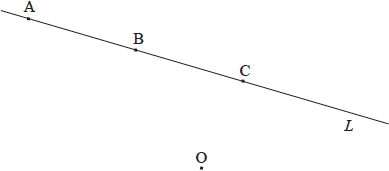
Point \(C\) has position vector \(\left( {\begin{array}{*{20}{c}} 0 \\ y \\ { – 1} \end{array}} \right)\).
Show that \(y = 2\).
(i) Find \(\overrightarrow {{\text{OC}}} \bullet \overrightarrow {{\text{AB}}} \).
(ii) Hence, write down the size of the angle between \(C\) and \(L\).
Hence or otherwise, find the area of triangle \(OAB\).
Answer/Explanation
Markscheme
(i) correct approach A1
eg\(\;\;\;{\text{B}} – {\text{A, AO}} + {\text{OB}}\)
\(\overrightarrow {{\text{AB}}} = \left( {\begin{array}{*{20}{c}} 1 \\ { – 1} \\ { – 2} \end{array}} \right)\) AG N0
(ii) correct substitution (A1)
eg\(\;\;\;\sqrt {{{(1)}^2} + {{( – 1)}^2} + {{( – 2)}^2}} ,{\text{ }}\sqrt {1 + 1 + 4} \)
\(\left| {\overrightarrow {{\text{AB}}} } \right| = \sqrt 6 \) A1 N2
[3 marks]
any correct equation in the form \(r = a + tb\) (any parameter for \(t\))
where \(a\) is \(\left( {\begin{array}{*{20}{c}} { – 2} \\ 4 \\ 3 \end{array}} \right)\) or \(\left( {\begin{array}{*{20}{c}} { – 1} \\ 3 \\ 1 \end{array}} \right)\) and \(b\) is a scalar multiple of \(\left( {\begin{array}{*{20}{c}} 1 \\ { – 1} \\ { – 2} \end{array}} \right)\) A2 N2
eg\(\;\;\;\(r\) = \left( {\begin{array}{*{20}{c}} { – 2} \\ 4 \\ 3 \end{array}} \right) + t\left( {\begin{array}{*{20}{c}} 1 \\ { – 1} \\ { – 2} \end{array}} \right),{\text{ }}(x,{\text{ }}y,{\text{ }}z) = ( – 1,{\text{ }}3,{\text{ }}1) + t(1,{\text{ }} – 1,{\text{ }} – 2),{\text{ }}{\mathbf{r}} = \left( {\begin{array}{*{20}{c}} { – 1 + t} \\ {3 – t} \\ {1 – 2t} \end{array}} \right)\)
Note: Award A1 for the form \({\mathbf{a}} + t{\mathbf{b}}\), A1 for the form \(L = {\mathbf{a}} + t{\mathbf{b}}\), A0 for the form \({\mathbf{r}} = {\mathbf{b}} + t{\mathbf{a}}\).
METHOD 1
valid approach (M1)
eg\(\;\;\;\left( {\begin{array}{*{20}{c}} { – 1} \\ 3 \\ 1 \end{array}} \right) + t\left( {\begin{array}{*{20}{c}} 1 \\ { – 1} \\ { – 2} \end{array}} \right) = \left( {\begin{array}{*{20}{c}} 0 \\ y \\ { – 1} \end{array}} \right),{\text{ }}\left( {\begin{array}{*{20}{c}} 0 \\ y \\ { – 1} \end{array}} \right) = \left( {\begin{array}{*{20}{c}} { – 2} \\ 4 \\ 3 \end{array}} \right) + s\left( {\begin{array}{*{20}{c}} 1 \\ { – 1} \\ { – 2} \end{array}} \right)\)
one correct equation from their approach A1
eg\(\;\;\; – 1 + t = 0,{\text{ }}1 – 2t = – 1,{\text{ }} – 2 + s = 0,{\text{ }}3 – 2s = – 1\)
one correct value for their parameter and equation A1
eg\(\;\;\;t = 1,{\text{ }}s = 2\)
correct substitution A1
eg\(\;\;\;3 + 1( – 1),{\text{ }}4 + 2( – 1)\)
\(y = 2\) AG N0
METHOD 2
valid approach (M1)
eg\(\;\;\;\overrightarrow {{\text{AC}}} = k\overrightarrow {{\text{AB}}} \)
correct working A1
eg\(\;\;\;\overrightarrow {{\text{AC}}} = \left( {\begin{array}{*{20}{c}} 2 \\ {y – 4} \\ { – 4} \end{array}} \right),{\text{ }}\left( {\begin{array}{*{20}{c}} 2 \\ {y – 4} \\ { – 4} \end{array}} \right) = k\left( {\begin{array}{*{20}{c}} 1 \\ { – 1} \\ { – 2} \end{array}} \right)\)
\(k = 2\) A1
correct substitution A1
eg\(\;\;\;y – 4 = – 2\)
\(y = 2\) AG N0
[4 marks]
(i) correct substitution A1
eg\(\;\;\;0(1) + 2( – 1) – 1( – 2),{\text{ }}0 – 2 + 2\)
\(\overrightarrow {{\text{OC}}} \bullet \overrightarrow {{\text{AB}}} = 0\) A1 N1
(ii) \(9{0^ \circ }\) or \(\frac{\pi }{2}\) A1 N1
[3 marks]
METHOD 1 \({\text{(area}} = 0.5 \times {\text{height}} \times {\text{base)}}\)
\(\left| {\overrightarrow {{\text{OC}}} } \right| = \sqrt {0 + {2^2} + {{( – 1)}^2}} \;\;\;\left( { = \sqrt 5 } \right)\;\;\;\)(seen anywhere) A1
valid approach (M1)
eg\(\;\;\;\frac{1}{2} \times \left| {\overrightarrow {{\text{AB}}} } \right| \times \left| {\overrightarrow {{\text{OC}}} } \right|,{\text{ }}\left| {\overrightarrow {{\text{OC}}} } \right|\) is height of triangle
correct substitution A1
eg\(\;\;\;\frac{1}{2} \times \sqrt 6 \times \sqrt {0 + {{(2)}^2} + {{( – 1)}^2}} ,{\text{ }}\frac{1}{2} \times \sqrt 6 \times \sqrt 5 \)
area is \(\frac{{\sqrt {30} }}{2}\) A1 N2
METHOD 2 (difference of two areas)
one correct magnitude (seen anywhere) A1
eg\(\;\;\;\left| {\overrightarrow {{\text{OC}}} } \right| = \sqrt {{2^2} + {{( – 1)}^2}} \;\;\;\left( { = \sqrt 5 } \right),\;\;\;\left| {\overrightarrow {{\text{AC}}} } \right| = \sqrt {4 + 4 + 16} \;\;\;\left( { = \sqrt {24} } \right),\;\;\;\left| {\overrightarrow {{\text{BC}}} } \right| = \sqrt 6 \)
valid approach (M1)
eg\(\;\;\;\Delta {\text{OAC}} – \Delta {\text{OBC}}\)
correct substitution A1
eg\(\;\;\;\frac{1}{2} \times \sqrt {24} \times \sqrt 5 – \frac{1}{2} \times \sqrt 5 \times \sqrt 6 \)
area is \(\frac{{\sqrt {30} }}{2}\) A1 N2
METHOD 3 \({\text{(area}} = \frac{1}{2}ab\sin C{\text{ for }}\Delta {\text{OAB)}}\)
one correct magnitude of \(\overrightarrow {{\text{OA}}} \) or \(\overrightarrow {{\text{OB}}} \) (seen anywhere) A1
eg\(\;\;\;\left| {\overrightarrow {{\text{OA}}} } \right| = \sqrt {{{( – 2)}^2} + {4^2} + {3^2}} \;\;\;\left( { = \sqrt {29} } \right),\;\;\;\left| {\overrightarrow {{\text{OB}}} } \right| = \sqrt {1 + 9 + 1} \;\;\;\left( { = \sqrt {11} } \right)\)
valid attempt to find \(\cos \theta \) or \(\sin \theta \) (M1)
eg\(\;\;\;\cos {\text{C}} = \frac{{ – 1 – 3 – 2}}{{\sqrt 6 \times \sqrt {11} }}\;\;\;\left( { = \frac{{ – 6}}{{\sqrt {66} }}} \right),\;\;\;29 = 6 + 11 – 2\sqrt 6 \sqrt {11} \cos \theta ,{\text{ }}\frac{{\sin \theta }}{{\sqrt 5 }} = \frac{{\sin 90}}{{\sqrt {29} }}\)
correct substitution into \(\frac{1}{2}ab\sin {\text{C}}\) A1
eg\(\;\;\;\frac{1}{2} \times \sqrt 6 \times \sqrt {11} \times \sqrt {1 – \frac{{36}}{{66}}} ,{\text{ }}0.5 \times \sqrt 6 \times \sqrt {29} \times \frac{{\sqrt 5 }}{{\sqrt {29} }}\)
area is \(\frac{{\sqrt {30} }}{2}\) A1 N2
[4 marks]
Total [16 marks]
Question
A line \({L_1}\) passes through the points \({\text{A}}(0,{\text{ }} – 3,{\text{ }}1)\) and \({\text{B}}( – 2,{\text{ }}5,{\text{ }}3)\).
(i) Show that \(\overrightarrow {{\text{AB}}} = \left( {\begin{array}{*{20}{c}} { – 2} \\ 8 \\ 2 \end{array}} \right)\).
(ii) Write down a vector equation for \({L_1}\).
A line \({L_2}\) has equation \({\mathbf{r}} = \left( {\begin{array}{*{20}{c}} { – 1} \\ 7 \\ { – 4} \end{array}} \right) + s\left( {\begin{array}{*{20}{c}} 0 \\ 1 \\ { – 1} \end{array}} \right)\). The lines \({L_1}\) and \({L_2}\) intersect at a point \(C\).
Show that the coordinates of \(C\) are \(( – 1,{\text{ }}1,{\text{ }}2)\).
A point \(D\) lies on line \({L_2}\) so that \(\left| {\overrightarrow {{\text{CD}}} } \right| = \sqrt {18} \) and \(\overrightarrow {{\text{CA}}} \bullet \overrightarrow {{\text{CD}}} = – 9\). Find \({\rm{A\hat CD}}\).
Answer/Explanation
Markscheme
(i) correct approach A1
eg\(\;\;\;{\text{OB}} – {\text{OA, }}\left( {\begin{array}{*{20}{c}} { – 2} \\ 5 \\ 3 \end{array}} \right) – \left( {\begin{array}{*{20}{c}} 0 \\ { – 3} \\ 1 \end{array}} \right),{\text{ B}} – {\text{A}}\)
\(\overrightarrow {{\text{AB}}} = \left( {\begin{array}{*{20}{c}} { – 2} \\ 8 \\ 2 \end{array}} \right)\) AG N0
(ii) any correct equation in the form \(r = a + \) t\(b\) (accept any parameter for \(t\))
where \(a\) is \(\left( {\begin{array}{*{20}{c}} 0 \\ { – 3} \\ 1 \end{array}} \right)\) or \(\left( {\begin{array}{*{20}{c}} { – 2} \\ 5 \\ 3 \end{array}} \right)\), and \(b\) is a scalar multiple of \(\left( {\begin{array}{*{20}{c}} { – 2} \\ 8 \\ 2 \end{array}} \right)\) A2 N2
eg\(r\) = \left( {\begin{array}{*{20}{c}} 0 \\ { – 3} \\ 1 \end{array}} \right) + t\left( {\begin{array}{*{20}{c}} { – 2} \\ 8 \\ 2 \end{array}} \right),\(r\) = \left( {\begin{array}{*{20}{c}} { – 2 – 2s} \\ {5 + 8s} \\ {3 + 2s} \end{array}} \right),\(r = 2i + 5j + 3k + \) t\(( – 2i + 8j + 2k)\)
Note: Award A1 for the form \(a\) + t\(b\), A1 for the form \(L = \(a\) + t\(b\),
A0 for the form \(r\) = \(b\) + t\(a\).
[3 marks]
valid approach (M1)
eg\(\;\;\;\)equating lines, \({L_1} = {L_2}\)
one correct equation in one variable A1
eg\(\;\;\; – 2t = – 1,{\text{ }} – 2 – 2t = – 1\)
valid attempt to solve (M1)
eg\(\;\;\;2t = 1,{\text{ }} – 2t = 1\)
one correct parameter A1
eg\(\;\;\;t = \frac{1}{2},{\text{ }}t = – \frac{1}{2},{\text{ }}s = – 6\)
correct substitution of either parameter A1
eg\(\;\;\;r = \left( {\begin{array}{*{20}{c}} 0 \\ { – 3} \\ 1 \end{array}} \right) + \frac{1}{2}\left( {\begin{array}{*{20}{c}} { – 2} \\ 8 \\ 2 \end{array}} \right),{\text{ }}r = \left( {\begin{array}{*{20}{c}} { – 2} \\ 5 \\ 3 \end{array}} \right) – \frac{1}{2}\left( {\begin{array}{*{20}{c}} { – 2} \\ 8 \\ 2 \end{array}} \right),{\text{ }}r = \left( {\begin{array}{*{20}{c}} { – 1} \\ 7 \\ { – 4} \end{array}} \right) – 6\left( {\begin{array}{*{20}{c}} 0 \\ 1 \\ { – 1} \end{array}} \right)\)
the coordinates of \(C\) are \(( – 1,{\text{ }}1,{\text{ }}2)\), or position vector of \(C\) is \(\left( {\begin{array}{*{20}{c}} { – 1} \\ 1 \\ 2 \end{array}} \right)\) AG N0
Note: If candidate uses the same parameter in both vector equations and working shown, award M1A1M1A0A0.
[5 marks]
valid approach (M1)
eg\(\;\;\;\)attempt to find \(\overrightarrow {{\text{CA}}} ,{\text{ }}\cos {\rm{A\hat CD}} = \frac{{\overrightarrow {{\text{CA}}} \bullet \overrightarrow {{\text{CD}}} }}{{\left| {\overrightarrow {{\text{CA}}} } \right|\left| {\overrightarrow {{\text{CD}}} } \right|}},{\rm{ A\hat CD}}\) formed by \(\overrightarrow {{\text{CA}}} \) and \(\overrightarrow {{\text{CD}}} \)
\(\overrightarrow {{\text{CA}}} = \left( {\begin{array}{*{20}{c}} 1 \\ { – 4} \\ { – 1} \end{array}} \right)\) (A1)
Notes: Exceptions to FT:
1 if candidate indicates that they are finding \(\overrightarrow {{\text{CA}}} \), but makes an error, award M1A0;
2 if candidate finds an incorrect vector (including \(\overrightarrow {{\text{AC}}} \)), award M0A0.
In both cases, if working shown, full FT may be awarded for subsequent correct FT work.
Award the final (A1) for simplification of their value for \({\rm{A\hat CD}}\).
Award the final A2 for finding their arc cos. If their value of cos does not allow them to find an angle, they cannot be awarded this A2.
finding \(\left| {\overrightarrow {{\text{CA}}} } \right|\) (may be seen in cosine formula) A1
eg\(\;\;\;\sqrt {{1^2} + {{( – 4)}^2} + {{( – 1)}^2}} ,{\text{ }}\sqrt {18} \)
correct substitution into cosine formula (A1)
eg\(\;\;\;\frac{{ – 9}}{{\sqrt {18} \sqrt {18} }}\)
finding \(\cos {\rm{A\hat CD}} – \frac{1}{2}\) (A1)
\({\rm{A\hat CD}} = \frac{{2\pi }}{3}\;\;\;(120^\circ )\) A2 N2
Notes: Award A1 if additional answers are given.
Award A1 for answer \(\frac{\pi }{3}{\rm{ (60^\circ )}}\).
[7 marks]
Total [15 marks]
Question
A line \(L\) passes through points \({\text{A}}( – 3,{\text{ }}4,{\text{ }}2)\) and \({\text{B}}( – 1,{\text{ }}3,{\text{ }}3)\).
The line \(L\) also passes through the point \({\text{C}}(3,{\text{ }}1,{\text{ }}p)\).
Show that \(\overrightarrow {{\text{AB}}} = \left( {\begin{array}{*{20}{c}} 2 \\ { – 1} \\ 1 \end{array}} \right)\).
Find a vector equation for \(L\).
Find the value of \(p\).
The point D has coordinates \(({q^2},{\text{ }}0,{\text{ }}q)\). Given that \(\overrightarrow {{\text{DC}}} \) is perpendicular to \(L\), find the possible values of \(q\).
Answer/Explanation
Markscheme
correct approach A1
eg\(\,\,\,\,\,\)\(\left( {\begin{array}{*{20}{c}} { – 1} \\ 3 \\ 3 \end{array}} \right) – \left( {\begin{array}{*{20}{c}} { – 3} \\ 4 \\ 2 \end{array}} \right),{\text{ }}\left( {\begin{array}{*{20}{c}} 3 \\ { – 4} \\ { – 2} \end{array}} \right) + \left( {\begin{array}{*{20}{c}} { – 1} \\ 3 \\ 3 \end{array}} \right)\)
\(\overrightarrow {{\text{AB}}} = \left( {\begin{array}{*{20}{c}} 2 \\ { – 1} \\ 1 \end{array}} \right)\) AG N0
[1 mark]
any correct equation in the form \(r = a + tb\) (any parameter for \(t\))
where \(a\) is \(\left( {\begin{array}{*{20}{c}} { – 3} \\ 4 \\ 2 \end{array}} \right)\) or \(\left( {\begin{array}{*{20}{c}} { – 1} \\ 3 \\ 3 \end{array}} \right)\) and \(b\) is a scalar multiple of \(\left( {\begin{array}{*{20}{c}} 2 \\ { – 1} \\ 1 \end{array}} \right)\) A2 N2
eg\(\,\,\,\,\,\)\(r = \left( {\begin{array}{*{20}{c}} { – 3} \\ 4 \\ 2 \end{array}} \right) + t\left( {\begin{array}{*{20}{c}} 2 \\ { – 1} \\ 1 \end{array}} \right),{\text{ }}(x,{\text{ }}y,{\text{ }}z) = ( – 1,{\text{ }}3,{\text{ }}3) + s( – 2,{\text{ }}1,{\text{ }} – 1),{\text{ }}r = \left( {\begin{array}{*{20}{c}} { – 3 + 2t} \\ {4 – t} \\ {2 + t} \end{array}} \right)\)
Note: Award A1 for the form \(a + tb\), A1 for the form \(L = a + tb\), A0 for the form \(r = b + ta\).
[2 marks]
METHOD 1 – finding value of parameter
valid approach (M1)
eg\(\,\,\,\,\,\)\(\left( {\begin{array}{*{20}{c}} { – 3} \\ 4 \\ 2 \end{array}} \right) + t\left( {\begin{array}{*{20}{c}} 2 \\ { – 1} \\ 1 \end{array}} \right) = \left( {\begin{array}{*{20}{c}} 3 \\ 1 \\ p \end{array}} \right),{\text{ }}( – 1,{\text{ }}3,{\text{ }}3) + s( – 2,{\text{ }}1,{\text{ }} – 1) = (3,{\text{ }}1,{\text{ }}p)\)
one correct equation (not involving \(p\)) (A1)
eg\(\,\,\,\,\,\)\( – 3 + 2t = 3,{\text{ }} – 1 – 2s = 3,{\text{ }}4 – t = 1,{\text{ }}3 + s = 1\)
correct parameter from their equation (may be seen in substitution) A1
eg\(\,\,\,\,\,\)\(t = 3,{\text{ }}s = – 2\)
correct substitution (A1)
eg\(\,\,\,\,\,\)\(\left( {\begin{array}{*{20}{c}} { – 3} \\ 4 \\ 2 \end{array}} \right) + 3\left( {\begin{array}{*{20}{c}} 2 \\ { – 1} \\ 1 \end{array}} \right) = \left( {\begin{array}{*{20}{c}} 3 \\ 1 \\ p \end{array}} \right),{\text{ }}3 – ( – 2)\)
\(p = 5\,\,\,\,\,\left( {{\text{accept }}\left( {\begin{array}{*{20}{c}} 3 \\ 1 \\ 5 \end{array}} \right)} \right)\) A1 N2
METHOD 2 – eliminating parameter
valid approach (M1)
eg\(\,\,\,\,\,\)\(\left( {\begin{array}{*{20}{c}} { – 3} \\ 4 \\ 2 \end{array}} \right) + t\left( {\begin{array}{*{20}{c}} 2 \\ { – 1} \\ 1 \end{array}} \right) = \left( {\begin{array}{*{20}{c}} 3 \\ 1 \\ p \end{array}} \right),{\text{ }}( – 1,{\text{ }}3,{\text{ }}3) + s( – 2,{\text{ }}1,{\text{ }} – 1) = (3,{\text{ }}1,{\text{ }}p)\)
one correct equation (not involving \(p\)) (A1)
eg\(\,\,\,\,\,\)\( – 3 + 2t = 3,{\text{ }} – 1 – 2s = 3,{\text{ }}4 – t = 1,{\text{ }}3 + s = 1\)
correct equation (with \(p\)) A1
eg\(\,\,\,\,\,\)\(2 + t = p,{\text{ }}3 – s = p\)
correct working to solve for \(p\) (A1)
eg\(\,\,\,\,\,\)\(7 = 2p – 3,{\text{ }}6 = 1 + p\)
\(p = 5\,\,\,\,\,\left( {{\text{accept }}\left( {\begin{array}{*{20}{c}} 3 \\ 1 \\ 5 \end{array}} \right)} \right)\) A1 N2
[5 marks]
valid approach to find \(\overrightarrow {{\text{DC}}} \) or \(\overrightarrow {{\text{CD}}} \) (M1)
eg\(\,\,\,\,\,\)\(\left( {\begin{array}{*{20}{c}} 3 \\ 1 \\ 5 \end{array}} \right) – \left( {\begin{array}{*{20}{c}} {{q^2}} \\ 0 \\ q \end{array}} \right),{\text{ }}\left( {\begin{array}{*{20}{c}} {{q^2}} \\ 0 \\ q \end{array}} \right) – \left( {\begin{array}{*{20}{c}} 3 \\ 1 \\ 5 \end{array}} \right),{\text{ }}\left( {\begin{array}{*{20}{c}} {{q^2}} \\ 0 \\ q \end{array}} \right) – \left( {\begin{array}{*{20}{c}} 3 \\ 1 \\ p \end{array}} \right)\)
correct vector for \(\overrightarrow {{\text{DC}}} \) or \(\overrightarrow {{\text{CD}}} \) (may be seen in scalar product) A1
eg\(\,\,\,\,\,\)\(\left( {\begin{array}{*{20}{c}} {3 – {q^2}} \\ 1 \\ {5 – q} \end{array}} \right),{\text{ }}\left( {\begin{array}{*{20}{c}} {{q^2} – 3} \\ { – 1} \\ {q – 5} \end{array}} \right),{\text{ }}\left( {\begin{array}{*{20}{c}} {3 – {q^2}} \\ 1 \\ {p – q} \end{array}} \right)\)
recognizing scalar product of \(\overrightarrow {{\text{DC}}} \) or \(\overrightarrow {{\text{CD}}} \) with direction vector of \(L\) is zero (seen anywhere) (M1)
eg\(\,\,\,\,\,\)\(\left( {\begin{array}{*{20}{c}} {3 – {q^2}} \\ 1 \\ {p – q} \end{array}} \right) \bullet \left( {\begin{array}{*{20}{c}} 2 \\ { – 1} \\ 1 \end{array}} \right) = 0,{\text{ }}\overrightarrow {{\text{DC}}} \bullet \overrightarrow {{\text{AC}}} = 0,{\text{ }}\left( {\begin{array}{*{20}{c}} {3 – {q^2}} \\ 1 \\ {5 – q} \end{array}} \right) \bullet \left( {\begin{array}{*{20}{c}} 2 \\ { – 1} \\ 1 \end{array}} \right) = 0\)
correct scalar product in terms of only \(q\) A1
eg\(\,\,\,\,\,\)\(6 – 2{q^2} – 1 + 5 – q,{\text{ }}2{q^2} + q – 10 = 0,{\text{ }}2(3 – {q^2}) – 1 + 5 – q\)
correct working to solve quadratic (A1)
eg\(\,\,\,\,\,\)\((2q + 5)(q – 2),{\text{ }}\frac{{ – 1 \pm \sqrt {1 – 4(2)( – 10)} }}{{2(2)}}\)
\(q = – \frac{5}{2},{\text{ }}2\) A1A1 N3
[7 marks]
Question
Six equilateral triangles, each with side length 3 cm, are arranged to form a hexagon.
This is shown in the following diagram.
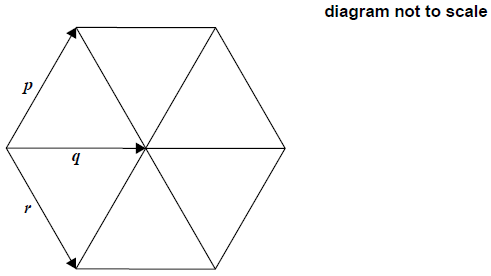
The vectors p , q and r are shown on the diagram.
Find p•(p + q + r).
Answer/Explanation
Markscheme
METHOD 1 (using |p| |2q| cosθ)
finding p + q + r (A1)
eg 2q, 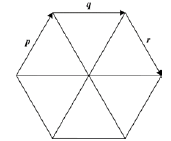
| p + q + r | = 2 × 3 (= 6) (seen anywhere) A1
correct angle between p and q (seen anywhere) (A1)
\(\frac{\pi }{3}\) (accept 60°)
substitution of their values (M1)
eg 3 × 6 × cos\(\left( {\frac{\pi }{3}} \right)\)
correct value for cos\(\left( {\frac{\pi }{3}} \right)\) (seen anywhere) (A1)
eg \(\frac{1}{2},\,\,\,3 \times 6 \times \frac{1}{2}\)
p•(p + q + r) = 9 A1 N3
METHOD 2 (scalar product using distributive law)
correct expression for scalar distribution (A1)
eg p• p + p•q + p•r
three correct angles between the vector pairs (seen anywhere) (A2)
eg 0° between p and p, \(\frac{\pi }{3}\) between p and q, \(\frac{{2\pi }}{3}\) between p and r
Note: Award A1 for only two correct angles.
substitution of their values (M1)
eg 3.3.cos0 +3.3.cos\(\frac{\pi }{3}\) + 3.3.cos120
one correct value for cos0, cos\(\left( {\frac{\pi }{3}} \right)\) or cos\(\left( {\frac{2\pi }{3}} \right)\) (seen anywhere) A1
eg \(\frac{1}{2},\,\,\,3 \times 6 \times \frac{1}{2}\)
p•(p + q + r) = 9 A1 N3
METHOD 3 (scalar product using relative position vectors)
valid attempt to find one component of p or r (M1)
eg sin 60 = \(\frac{x}{3}\), cos 60 = \(\frac{x}{3}\), one correct value \(\frac{3}{2},\,\,\frac{{3\sqrt 3 }}{2},\,\,\frac{{ – 3\sqrt 3 }}{2}\)
one correct vector (two or three dimensions) (seen anywhere) A1
eg \(p = \left( \begin{gathered}
\,\,\,\frac{3}{2} \hfill \\
\frac{{3\sqrt 3 }}{2} \hfill \\
\end{gathered} \right),\,\,q = \left( \begin{gathered}
3 \hfill \\
0 \hfill \\
\end{gathered} \right),\,\,r = \left( \begin{gathered}
\,\,\,\,\frac{3}{2} \hfill \\
– \frac{{3\sqrt 3 }}{2} \hfill \\
\,\,\,\,0 \hfill \\
\end{gathered} \right)\)
three correct vectors p + q + r = 2q (A1)
p + q + r = \(\left( \begin{gathered}
6 \hfill \\
0 \hfill \\
\end{gathered} \right)\) or \(\left( \begin{gathered}
6 \hfill \\
0 \hfill \\
0 \hfill \\
\end{gathered} \right)\) (seen anywhere, including scalar product) (A1)
correct working (A1)
eg \(\left( {\frac{3}{2} \times 6} \right) + \left( {\frac{{3\sqrt 3 }}{2} \times 0} \right),\,\,9 + 0 + 0\)
p•(p + q + r) = 9 A1 N3
[6 marks]
Question
Point A has coordinates (−4, −12, 1) and point B has coordinates (2, −4, −4).
The line L passes through A and B.
Show that \(\mathop {{\text{AB}}}\limits^ \to = \left( \begin{gathered}
\,6 \hfill \\
\,8 \hfill \\
– 5 \hfill \\
\end{gathered} \right)\)
Find a vector equation for L.
Point C (k , 12 , −k) is on L. Show that k = 14.
Find \(\mathop {{\text{OB}}}\limits^ \to \, \bullet \mathop {{\text{AB}}}\limits^ \to \).
Write down the value of angle OBA.
Point D is also on L and has coordinates (8, 4, −9).
Find the area of triangle OCD.
Answer/Explanation
Markscheme
correct approach A1
eg \(\mathop {{\text{AO}}}\limits^ \to \,\, + \,\,\mathop {{\text{OB}}}\limits^ \to ,\,\,\,{\text{B}} – {\text{A}}\,{\text{, }}\,\left( \begin{gathered}
\,\,2 \hfill \\
– 4 \hfill \\
– 4 \hfill \\
\end{gathered} \right) – \left( \begin{gathered}
\, – 4 \hfill \\
– 12 \hfill \\
\,\,\,1 \hfill \\
\end{gathered} \right)\)
\(\mathop {{\text{AB}}}\limits^ \to = \left( \begin{gathered}
\,6 \hfill \\
\,8 \hfill \\
– 5 \hfill \\
\end{gathered} \right)\) AG N0
[1 mark]
any correct equation in the form r = a + tb (any parameter for t) A2 N2
where a is \(\left( \begin{gathered}
\,\,2 \hfill \\
– 4 \hfill \\
– 4 \hfill \\
\end{gathered} \right)\) or \(\left( \begin{gathered}
\, – 4 \hfill \\
– 12 \hfill \\
\,\,\,1 \hfill \\
\end{gathered} \right)\) and b is a scalar multiple of \(\left( \begin{gathered}
\,6 \hfill \\
\,8 \hfill \\
– 5 \hfill \\
\end{gathered} \right)\)
eg r \( = \left( \begin{gathered}
\, – 4 \hfill \\
– 12 \hfill \\
\,\,\,1 \hfill \\
\end{gathered} \right) + t\left( \begin{gathered}
\,6 \hfill \\
\,8 \hfill \\
– 5 \hfill \\
\end{gathered} \right),\,\,\left( {x,\,\,y,\,\,z} \right) = \left( {2,\,\, – 4,\,\, – 4} \right) + t\left( {6,\,\,8,\,\, – 5} \right),\) r \( = \left( \begin{gathered}
\, – 4 + 6t \hfill \\
– 12 + 8t \hfill \\
\,\,\,1 – 5t \hfill \\
\end{gathered} \right)\)
Note: Award A1 for the form a + tb, A1 for the form L = a + tb, A0 for the form r = b + ta.
[2 marks]
METHOD 1 (solving for t)
valid approach (M1)
eg \(\left( \begin{gathered}
\,k \hfill \\
12 \hfill \\
– k \hfill \\
\end{gathered} \right) = \left( \begin{gathered}
\,\,2 \hfill \\
– 4 \hfill \\
– 4 \hfill \\
\end{gathered} \right) + t\left( \begin{gathered}
\,6 \hfill \\
\,8 \hfill \\
– 5 \hfill \\
\end{gathered} \right),\,\,\left( \begin{gathered}
\,k \hfill \\
12 \hfill \\
– k \hfill \\
\end{gathered} \right) = \left( \begin{gathered}
\, – 4 \hfill \\
– 12 \hfill \\
\,\,\,1 \hfill \\
\end{gathered} \right) + t\left( \begin{gathered}
\,6 \hfill \\
\,8 \hfill \\
– 5 \hfill \\
\end{gathered} \right)\)
one correct equation A1
eg −4 + 8t = 12, −12 + 8t = 12
correct value for t (A1)
eg t = 2 or 3
correct substitution A1
eg 2 + 6(2), −4 + 6(3), −[1 + 3(−5)]
k = 14 AG N0
METHOD 2 (solving simultaneously)
valid approach (M1)
eg \(\left( \begin{gathered}
\,k \hfill \\
12 \hfill \\
– k \hfill \\
\end{gathered} \right) = \left( \begin{gathered}
\,\,2 \hfill \\
– 4 \hfill \\
– 4 \hfill \\
\end{gathered} \right) + t\left( \begin{gathered}
\,6 \hfill \\
\,8 \hfill \\
– 5 \hfill \\
\end{gathered} \right),\,\,\left( \begin{gathered}
\,k \hfill \\
12 \hfill \\
– k \hfill \\
\end{gathered} \right) = \left( \begin{gathered}
\, – 4 \hfill \\
– 12 \hfill \\
\,\,\,1 \hfill \\
\end{gathered} \right) + t\left( \begin{gathered}
\,6 \hfill \\
\,8 \hfill \\
– 5 \hfill \\
\end{gathered} \right)\)
two correct equations in A1
eg k = −4 + 6t, −k = 1 −5t
EITHER (eliminating k)
correct value for t (A1)
eg t = 2 or 3
correct substitution A1
eg 2 + 6(2), −4 + 6(3)
OR (eliminating t)
correct equation(s) (A1)
eg 5k + 20 = 30t and −6k − 6 = 30t, −k = 1 − 5\(\left( {\frac{{k + 4}}{6}} \right)\)
correct working clearly leading to k = 14 A1
eg −k + 14 = 0, −6k = 6 −5k − 20, 5k = −20 + 6(1 + k)
THEN
k = 14 AG N0
[4 marks]
correct substitution into scalar product A1
eg (2)(6) − (4)(8) − (4)(−5), 12 − 32 + 20
\(\mathop {{\text{OB}}}\limits^ \to \, \bullet \mathop {{\text{AB}}}\limits^ \to \) = 0 A1 N0
[2 marks]
\({\text{O}}\mathop {\text{B}}\limits^ \wedge {\text{A}} = \frac{\pi }{2},\,\,90^\circ \,\,\,\,\,\left( {{\text{accept}}\,\frac{{3\pi }}{2},\,\,270^\circ } \right)\,\) A1 N1
[1 marks]
METHOD 1 (\(\frac{1}{2}\) × height × CD)
recognizing that OB is altitude of triangle with base CD (seen anywhere) M1
eg \(\frac{1}{2} \times \left| {\mathop {{\text{OB}}}\limits^ \to } \right| \times \left| {\mathop {{\text{CD}}}\limits^ \to } \right|,\,\,{\text{OB}} \bot {\text{CD}},\) sketch showing right angle at B
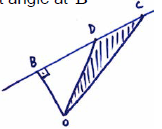
\(\mathop {{\text{CD}}}\limits^ \to = \left( \begin{gathered}
– 6 \hfill \\
– 8 \hfill \\
\,5 \hfill \\
\end{gathered} \right)\) or \(\mathop {{\text{DC}}}\limits^ \to = \left( \begin{gathered}
\,6 \hfill \\
\,8 \hfill \\
– 5 \hfill \\
\end{gathered} \right)\) (seen anywhere) (A1)
correct magnitudes (seen anywhere) (A1)(A1)
\(\left| {\mathop {{\text{OB}}}\limits^ \to } \right| = \sqrt {{{\left( 2 \right)}^2} + {{\left( { – 4} \right)}^2} + {{\left( { – 4} \right)}^2}} = \left( {\sqrt {36} } \right)\)
\(\left| {\mathop {{\text{CD}}}\limits^ \to } \right| = \sqrt {{{\left( { – 6} \right)}^2} + {{\left( { – 8} \right)}^2} + {{\left( 5 \right)}^2}} = \left( {\sqrt {125} } \right)\)
correct substitution into \(\frac{1}{2}bh\) A1
eg \(\frac{1}{2} \times 6 \times \sqrt {125} \)
area \( = 3\sqrt {125} ,\,\,15\sqrt 5 \) A1 N3
METHOD 2 (subtracting triangles)
recognizing that OB is altitude of either ΔOBD or ΔOBC(seen anywhere) M1
eg \(\frac{1}{2} \times \left| {\mathop {{\text{OB}}}\limits^ \to } \right| \times \left| {\mathop {{\text{BD}}}\limits^ \to } \right|,\,\,{\text{OB}} \bot {\text{BC}},\) sketch of triangle showing right angle at B
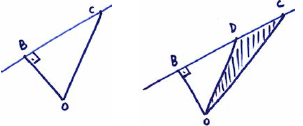
one correct vector \(\mathop {{\text{BD}}}\limits^ \to \) or \(\mathop {{\text{DB}}}\limits^ \to \) or \(\mathop {{\text{BC}}}\limits^ \to \) or \(\mathop {{\text{CB}}}\limits^ \to \) (seen anywhere) (A1)
eg \(\mathop {{\text{BD}}}\limits^ \to = \left( \begin{gathered}
\,6 \hfill \\
\,8 \hfill \\
– 5 \hfill \\
\end{gathered} \right)\), \(\mathop {{\text{CB}}}\limits^ \to = \left( \begin{gathered}
– 12 \hfill \\
– 16 \hfill \\
\,10 \hfill \\
\end{gathered} \right)\)
\(\left| {\mathop {{\text{OB}}}\limits^ \to } \right| = \sqrt {{{\left( 2 \right)}^2} + {{\left( { – 4} \right)}^2} + {{\left( { – 4} \right)}^2}} = \left( {\sqrt {36} } \right)\) (seen anywhere) (A1)
one correct magnitude of a base (seen anywhere) (A1)
\(\left| {\mathop {{\text{BD}}}\limits^ \to } \right| = \sqrt {{{\left( 6 \right)}^2} + {{\left( 8 \right)}^2} + {{\left( 5 \right)}^2}} = \left( {\sqrt {125} } \right),\,\,\left| {\mathop {{\text{BC}}}\limits^ \to } \right| = \sqrt {144 + 256 + 100} = \left( {\sqrt {500} } \right)\)
correct working A1
eg \(\frac{1}{2} \times 6 \times \sqrt {500} – \frac{1}{2} \times 6 \times 5\sqrt 5 ,\,\,\frac{1}{2} \times 6 \times \sqrt {500} \times {\text{sin}}90 – \frac{1}{2} \times 6 \times 5\sqrt 5 \times {\text{sin}}90\)
area \( = 3\sqrt {125} ,\,\,15\sqrt 5 \) A1 N3
METHOD 3 (using \(\frac{1}{2}\)ab sin C with ΔOCD)
two correct side lengths (seen anywhere) (A1)(A1)
\(\left| {\mathop {{\text{OD}}}\limits^ \to } \right| = \sqrt {{{\left( 8 \right)}^2} + {{\left( 4 \right)}^2} + {{\left( { – 9} \right)}^2}} = \left( {\sqrt {161} } \right),\,\,\left| {\mathop {{\text{CD}}}\limits^ \to } \right| = \sqrt {{{\left( { – 6} \right)}^2} + {{\left( { – 8} \right)}^2} + {{\left( 5 \right)}^2}} = \left( {\sqrt {125} } \right),\,\) \(\left| {\mathop {{\text{OC}}}\limits^ \to } \right| = \sqrt {{{\left( {14} \right)}^2} + {{\left( {12} \right)}^2} + {{\left( { – 14} \right)}^2}} = \left( {\sqrt {536} } \right)\)
attempt to find cosine ratio (seen anywhere) M1
eg \(\frac{{536 – 286}}{{ – 2\sqrt {161} \sqrt {125} }},\,\,\frac{{{\text{OD}} \bullet {\text{DC}}}}{{\left| {OD} \right|\left| {DC} \right|}}\)
correct working for sine ratio A1
eg \(\frac{{{{\left( {125} \right)}^2}}}{{161 \times 125}} + {\text{si}}{{\text{n}}^2}\,D = 1\)
correct substitution into \(\frac{1}{2}ab\,\,{\text{sin}}\,C\) A1
eg \(0.5 \times \sqrt {161} \times \sqrt {125} \times \frac{6}{{\sqrt {161} }}\)
area \( = 3\sqrt {125} ,\,\,15\sqrt 5 \) A1 N3
[6 marks]

